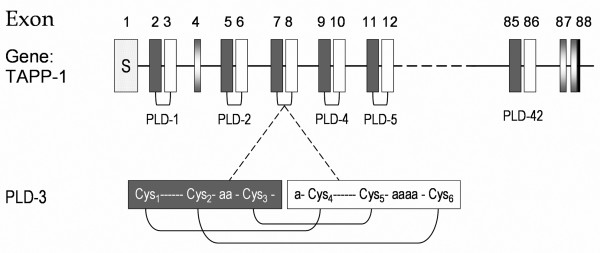Figure 1.
Gene structure of the tapp-1 gene of Trichoplax adhaerens. The upper part of the figure visualizes the tapp-1 gene structure. The 88 exons are depicted as boxes and numbered accordingly, while the horizontal connecting lines represent the intron regions. The first box corresponds to the exon that codes for the signal peptide (S). The exons in grey and white encode the respective first and last half of a particular PLD-related domain. Exons 4, 87 and 88 correspond to regions of the tapp-1 gene that do not code for PLD-related inhibitor domains. The last box (exon 88) contains the stop codon (shown in black). The bottom part of the figure shows in more detail how the combination of two exons (7 and 8) is needed to form one PLD-related domain (e.g. PLD-3). For every 'exon-pair', the first exon codes for the first three cysteine residues of the PLD-related domain (in grey), while the last three cysteines are encoded by the second exon (in black). The diagram underneath illustrates the topography of the three disulfide bridges stabilizing the typical pacifastin-like fold.

